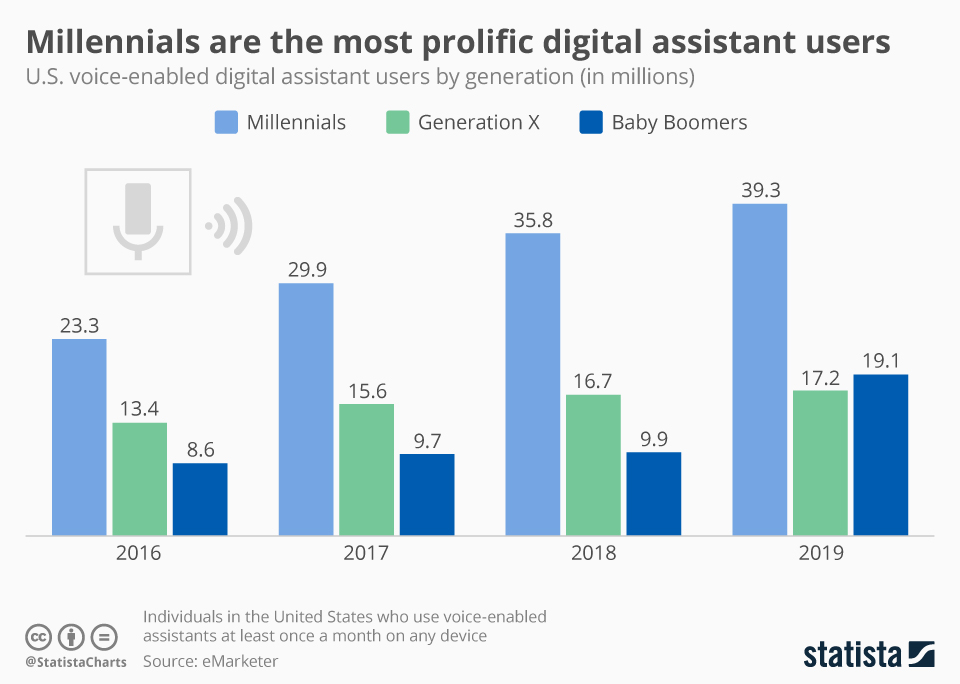- Apple bought Irish Voice AI specialist Voysis in April 2020
- Amazon already provides Voice Content monetization tools
- Voice-based user interfaces services expected to be worth $ 7.7 billion by 2025
Apple is looking to compete with Google’s Assistant and Amazon’s Alexa in the area of assistant/speaker devices. Until today Siri has not been able to fully match the other two competitors on speech recognition. This acquisition should be a valuable boost to its capability for natural voice language recognition. The war for ownership of a voice assistant is getting fiercer.

There is a bigger trend to be reported here: the increase of voice based service. According to Statista in Q4 2019 alone, Amazon sold 15 million smart speakers, and Google 12.5 million. Other Chinese vendors were reported shipping about 15.9 million devices (Alibaba, Baidu and Xiaomi), and these numbers are to be added to the about 380 million smartphones shipped worldwide each three months. The digital speakers / voice assistants are coming. Is this going to create a new voice-based service growth?
According to Statista, the use of voice enable assistants is reaching the mass market among Millennials (people born from 1981 and 2000). Already 39% of USA Millennials used voice search at least once a month in 2019. While the other segments are lagging behind – this is a trend growing year on year across Millennials, Generation X and Baby Boomers.
The Mobile Industry should play attention, this is potentially the latest change in the UI paradigm.
After all, the arrival of the ‘touch’ user interface created a new wave of content services based on ‘Apps’. It should not be much of a surprise that voice-enabled services would equally sit well with the original voice central medium: the phone.
According to Tratica, the market for virtual digital assistants will reach $4 billion in 2022 and $7.7 billion in 2025 when VDA users will surpass one billion. The enterprise services there will be dominated by Customer Service & Marketing services, followed by e-commerce and healthcare, however, services such as Foreign Language Tutoring, and Tax Filing are included in the list.
There are 5 things to look forward in voice assisted UI services:
- Think Voice Monetization. Multiple voice application stores exist, before engaging consider the potential for monetisation. For instance, Amazon offers Amazon Pay to buy new ‘skills’ for Alexa. The tools are available: by introducing in-skill purchases, Amazon is encouraging the sale of premium content and digital subscriptions within their user base. In other stores, your services might have to be more app centric to be able to monetise services. With voice another UI layer on top.
- Think Voice First. Engaging voice/speech interaction: make sure the service is designed ground up to be easy to understand and use via voice. Apple and the other platforms could provide the best voice recognition software, but users will not want to learn how to use services.
- Think Voice Content. Do not just re-purpose content, provide a real experience around voice. The interest in using voice for gimmicks will wane easily, create value with voice services where other hands-on experiences cannot compete: ease of use, night use, elderly, toddlers, in-car, multitasking.
- Think Voice Feedback. Feedback is part of a conversation, your service should treat be enjoyed interactively, not filled of “Error messages’. Learn how to talk back to users.
- Think Voice Retention. The big challenge of voice services is the lack of visual clues to make users come back. Inbuild customer retention in your design flow. Make sure that you voice app is not a one-time-experience.
If your company is working in the Voice-Assistant economy, we would like to hear your experience and share with the members of the MEF – get in touch.







